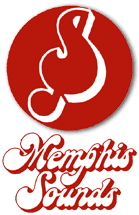
 |
Memphis SoundsYear of existence: 1974-75
|
Back to "Remember the ABA" Main Page
Did you see a Memphis Sounds game? Or, did you have a favorite Sounds player? Contribute to this web page by
After his Memphis Tams posted the worst record in all of pro basketball during the 1973-74 season, Charlie Finley refused to pay any more bills. The ABA itself was keeping the operation afloat. After four years of futility, starting with the gradual demise of the Memphis Pros and ending with the debacle of the Tams, it seemed impossible that the Memphis ABA franchise could continue. But some continued to believe that Memphis would support a well-run, first-class ABA franchise. And, some also believed that an ABA/NBA merger was imminent, and that it made sense for the franchise to hang on and be a part of it.
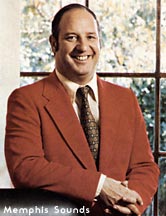 With these thoughts in mind, ABA Commissioner Mike Storen (at left) studied the situation. Within the ABA, Storen was highly-regarded as a franchise builder. In previous years, he had constructed strong, successful ABA franchises in Indiana and Kentucky. Given his past success, Storen felt that he could turn around the Memphis franchise and make it viable for the NBA. In July 1974, Storen found several new local investors for the team (including Isaac Hayes and Al Wilson of Stax Records, Kemmons Wilson of Holiday Inn, and Avron Fogelman, a Memphis businessman). Then on July 17, 1974, to the surprise of most everyone, Storen resigned as ABA Commissioner and stepped in to run the team himself. At the time, Storen stated that: "In the past, I have been almost vehement in my belief the city of Memphis could be a great basketball town. I've seen it as both an operator and as commissioner. I believe in Memphis."
With these thoughts in mind, ABA Commissioner Mike Storen (at left) studied the situation. Within the ABA, Storen was highly-regarded as a franchise builder. In previous years, he had constructed strong, successful ABA franchises in Indiana and Kentucky. Given his past success, Storen felt that he could turn around the Memphis franchise and make it viable for the NBA. In July 1974, Storen found several new local investors for the team (including Isaac Hayes and Al Wilson of Stax Records, Kemmons Wilson of Holiday Inn, and Avron Fogelman, a Memphis businessman). Then on July 17, 1974, to the surprise of most everyone, Storen resigned as ABA Commissioner and stepped in to run the team himself. At the time, Storen stated that: "In the past, I have been almost vehement in my belief the city of Memphis could be a great basketball town. I've seen it as both an operator and as commissioner. I believe in Memphis."
He gave the franchise a complete facelift. First, he changed the nickname to the "Sounds" and adopted a classy new logo (above). As ABA writer Jim O'Brien noted, "This club has been known as the Pros and then as the Tams, but both of those names sound like something you order by whispering in a drug store, and Storen thought that the Sounds was a change for the best."
Then Storen started wheeling and dealing, and gave the team itself a badly-needed overhaul. He brought in established ABA veterans like Mel Daniels, Freddie Lewis, Roger Brown, George Carter, Chuck Williams, Collis Jones, Rick Mount, and Julius Keye. The only Tams player kept on the roster was guard Larry Finch, a local favorite out of Memphis State. It was an all-new team - an older group with a lot of winning and playoff experience.
Joe Mullaney, a respected and familiar ABA face, was hired as the new coach. With complete change in personnel, both on and off the court, plus new ownership, there was actually reason for some optimism at the beginning of the 1974-75 season.
On October 18, 1974, the Sounds debuted in St. Louis and ruined the Spirits' home opener with a 97-92 win. Freddie Lewis led the Sounds with 34 points.
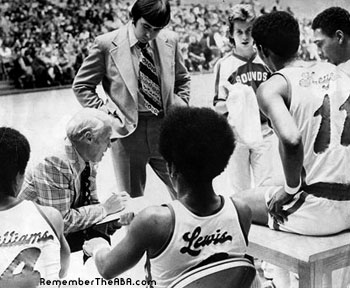 On October 22, 1974, the Sounds played their own home opener against the San Diego Conquistadors (photo at right). A semi-curious crowd of 4,010 showed up at the Mid-South Coliseum only to go home disappointed. The Sounds played no defense. Travis "Machine Gun" Grant, a San Diego guard, played only 22 minutes, but went 15 of 21 from the floor and 11 for 11 from the line (with 15 of his 41 points in the 4th quarter) to lead the Q's to a 109-106 come-from-behind victory. Lewis once again led the Sounds in scoring with 25 points (15 of them in the fourth quarter).
On October 22, 1974, the Sounds played their own home opener against the San Diego Conquistadors (photo at right). A semi-curious crowd of 4,010 showed up at the Mid-South Coliseum only to go home disappointed. The Sounds played no defense. Travis "Machine Gun" Grant, a San Diego guard, played only 22 minutes, but went 15 of 21 from the floor and 11 for 11 from the line (with 15 of his 41 points in the 4th quarter) to lead the Q's to a 109-106 come-from-behind victory. Lewis once again led the Sounds in scoring with 25 points (15 of them in the fourth quarter).
The Sounds then proceeded to lose 9 of their first 10 home games, spoiling any chance they had to get some positive press and new fans.
The Sounds' poor start was partly due to injuries to key players early in the season. In November, team captain Mel Daniels suffered pulled stomach muscles and was out for a month. Then, as he was about to return, he slipped in a bathtub, hurt his back, and went on the injured list yet again. Without any legitimate center to replace Daniels, the Sounds were forced to deal Lewis to St. Louis in exchange for Tom Owens. Owens tried to plug a serious gap in the middle.
Guard Rick Mount, always a pure shooter, got off to a tremendous start with Memphis. He was having his best pro season and was leading the team with a 20.1 ppg scoring average after the departure of Lewis. But in early December, he suffered a shoulder separation that sidelined him for 58 games.
The Sounds had really banked on the three former Pacer All-Stars (Lewis, Brown and Daniels) being close to their championship form. But Lewis was gone after only six games, Brown was also traded (to the Utah Stars), and Daniels was not always effective after his early-season injuries. The main scoring load fell on other players like Stew Johnson, George Carter, Collis Jones and Chuck Williams.
 |
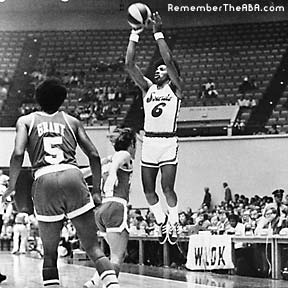 |
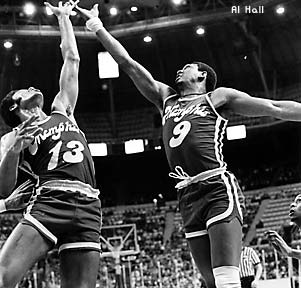 |
The Sounds pinned their hopes on three former Indiana Pacer All-Stars: Mel Daniels Lewis was spectacular in the Sounds' first several games. So good that when Daniels got hurt, and the Sounds were desperate for a legitimate center, Memphis used Lewis as trade bait. Lewis only played six games for the Sounds before being shipped to the Spirits of St. Louis for Tom Owens. Brown struggled in Memphis. Only a few days after the Lewis trade, he was sent to the Utah Stars. Daniels was the only one of the three to stick around. While he was obviously on the downside of his career, he did a nice job for Coach Mullaney with 9.8 points and 9.0 rebounds per game. While he was with the Sounds, Daniels was able to solidify his all-time ABA rebound mark -- he ended up with 9,494 total rebounds in his ABA career. |
With all of the various injuries and trades, the team struggled to find an identity. However, in contrast to previous Memphis teams, the Sounds eventually learned to play together. After all, most of the players were longtime ABA veterans and knew how to run a deliberate, patterned offense. As the season went on, the Sounds had their moments.
On January 15, 1975, Stew Johnson had a memorable night, as he led the Sounds to a 104-99 victory in St. Louis over the Spirits. Johnson hit 16 field goals in the second half (tying an ABA record held by teammate Daniels). Overall, he went 16-20 from the field and ended up with 40 points on a variety of twisting jump shots. Spirits defender Goo Kennedy said: "I was right in his face several times and I couldn't stop him. He's a super shooter when he gets hot." A couple of weeks later, on February 26, Johnson had another highlight - he hit his 10,000th ABA career point in another victory over the Spirits in Memphis. Johnson was the ninth ABA player to reach this milestone, and was presented with a huge red and white cake with the inscription "Congratulations Stew on 10,000 points."
A few nights later, on March 1, 1975, the Sounds hosted the powerful Western Division-leading Denver Nuggets in a physical game that, according to the Memphis Commercial Appeal, "had all the elements of a cockfight, a demolition derby and calf-roping." In front of 5,910 interested fans, the Sounds edged the Nuggets 109-105. Johnson continued his hot shooting, getting 27 points and 9 rebounds. Daniels, showing his former All-Star form, relieved Tom Owens in the fourth quarter and pushed the Sounds back from a 12 point (97-85) deficit in the final six minutes. He had 10 points and 15 rebounds in only 22 minutes of play. After the hard-fought victory, Daniels noted, "That's the name of the game. It's not love and kisses. It's rough stuff. That's the way it's supposed to be played."
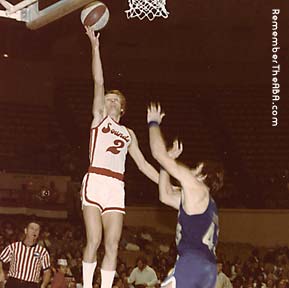 |
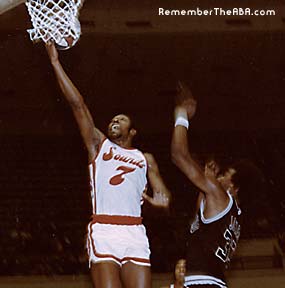 |
|
After Roger Brown and Freddie Lewis were traded early in the season, and Mel Daniels got hurt, the Sounds got their scoring from some other sources.
Chuck Williams (right, Forward George Carter (above right, Rick Mount (above left, |
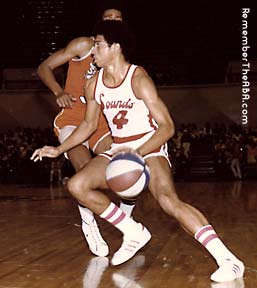 |
While the Sounds continued to improve late in the season, rumors swirled about the team's future. Storen expressed frustration about the team's lease with the Mid-South Coliseum - negotiations for getting a long-term arrangement in place were going nowhere. The league started paying many of the bills to keep the team alive. George Carter had this to say: "We're trying to win as many as we can. But the situation in Memphis does bother us. Everybody's struggling, and the uncertainty compounds things for us." Daniels also chimed in: "Our record is not indicative of the type of players we have on this team, I'll tell you that. It's just a shame we don't have the support we should. We have some good basketball players on this team."
In late March, the Sounds put it all together. They went on a three-game road winning streak (San Diego, Utah and Virginia) and clinched a playoff spot. It was the first time the franchise had made the playoffs since the 1970-71 season. The Sounds won six of nine games and drew four straight home crowds of over 6,000. Then on March 28, 1975, Memphis beat Dr. J and the New York Nets 111-106 at the Mid-South Coliseum in front of 8,417 fans - the largest crowd ever to see the Sounds (and the largest Memphis ABA crowd in several years). Daniels scored 14 points (all in the fourth quarter) and Owens scored 20 points to help Memphis overcome a 13-point third quarter deficit. The victory prevented the Nets from clinching the Eastern Division crown (and ultimately cost New York the Eastern Division title).
The Sounds ended up with 27 wins during the 1974-75 season. While this number did not seem impressive by itself, it was actually the second largest total in the team's five years in Memphis.
 |
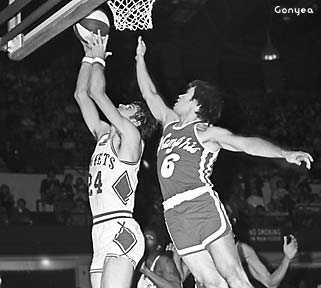 |
|
These players were vital contributors to the Sounds' late-season success.
Stew Johnson (above left, autographing the ball) was a eight-year ABA veteran. Before playing for the Sounds, he had played for the New Jersey Americans, New York Nets, Houston Mavericks, Pittsburgh Pipers, Pittsburgh Condors, Carolina Cougars, and San Diego Conquistadors. Wherever Johnson went, he could always score with his patented, deadly baseline jumper. In Memphis, he was in fine form, scoring more than 40 points in several games. Billy Shepherd (above left next to Johnson, and above right, # 6), was 5' 10" guard. He caught on with the Sounds after the San Diego Conquistadors cut him early in November 1974. As it turned out, San Diego made a serious mistake. With the Sounds, Shepherd had a most extraordinary season from beyond the three-point arc. He hit 60 of 143 three-pointers, for an amazing 42% accuracy mark. He broke the record set by Utah's Glen Combs during the 1971-72 season, when Combs connected on 103 of 254 three-point attempts for a 40.6% success rate. Collis Jones (right, # 13) and Tom Owens (right, # 25) also played well with the Sounds. Jones was a steady contributor off the bench during the entire season, especially on the defensive end. Owens came from the Spirits of St. Louis in November and provided a strong rebounding and inside scoring presence. Without Owens, the Sounds would have been in serious trouble the entire year. In fact, many observers credited the team's late-season run to Owen's steady play in the middle. |
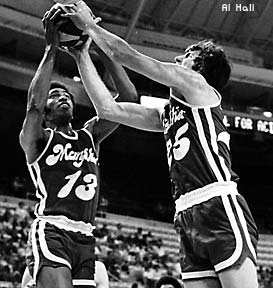 |
The Sounds faced the Kentucky Colonels in the first round of the 1975 ABA Playoffs. The Colonels were on a roll, having just defeated the Nets in a special one-game playoff for the Eastern Division title. Kentucky dismantled the Sounds in the first three games of the series by scores of 98-91 (Game 1 at Louisville), 119-105 (Game 2 at Louisville), and 101-80 (Game 3 at Memphis). In Game 4 at Memphis in front of 4,771 fans, the Sounds showed some fight by forging a 14-point halftime lead and breezing to a 107-93 victory. Stew Johnson scored 25 points, and Tom Owens, Chuck Williams and George Carter each scored 24 to help Memphis to the win - the first ever playoff win for the Memphis ABA franchise. But two days later, back in Louisville, the Colonels put away the Sounds for good by the score of 111-99. Kentucky went on to the win the ABA title - losing only two more playoff games in the process.
Despite the team's late season run, it was finally the "end of the line" for the ABA in Memphis. ABA Commissioner Tedd Munchak gave the city of Memphis a strict deadline of June 1, 1975 to sell 4,000 season tickets, find new investors, and secure a more favorable lease at the Mid-South Coliseum. Predictably, none of this happened. The league took over the franchise and, in August 1975, the Sounds were sold to several businessmen in Baltimore. In bizarre fashion, the franchise died there as the Baltimore Claws, without ever playing another regular season game.
Sounds 1974-75 Home Uniform |
Sounds 1974-75 Road Warmup |
Sounds 1974-75 Road Warmup |
1974-75 Memphis Sounds
Record: 27-57, Fourth Place in Eastern Division
1975 Playoff Results:1975 Eastern Division Semifinals vs. Kentucky Colonels (58-26)
Colonels won series, 4-1
Thanks to John G. Schmitz, Al Hall and Brian Clark for their valuable contributions to this page.
Some of the Memphis Sounds photos above are copyright © Albert Hall and used with permission. Interested in obtaining an 8x10 print of these or other ABA photos? and let him know of your interest.